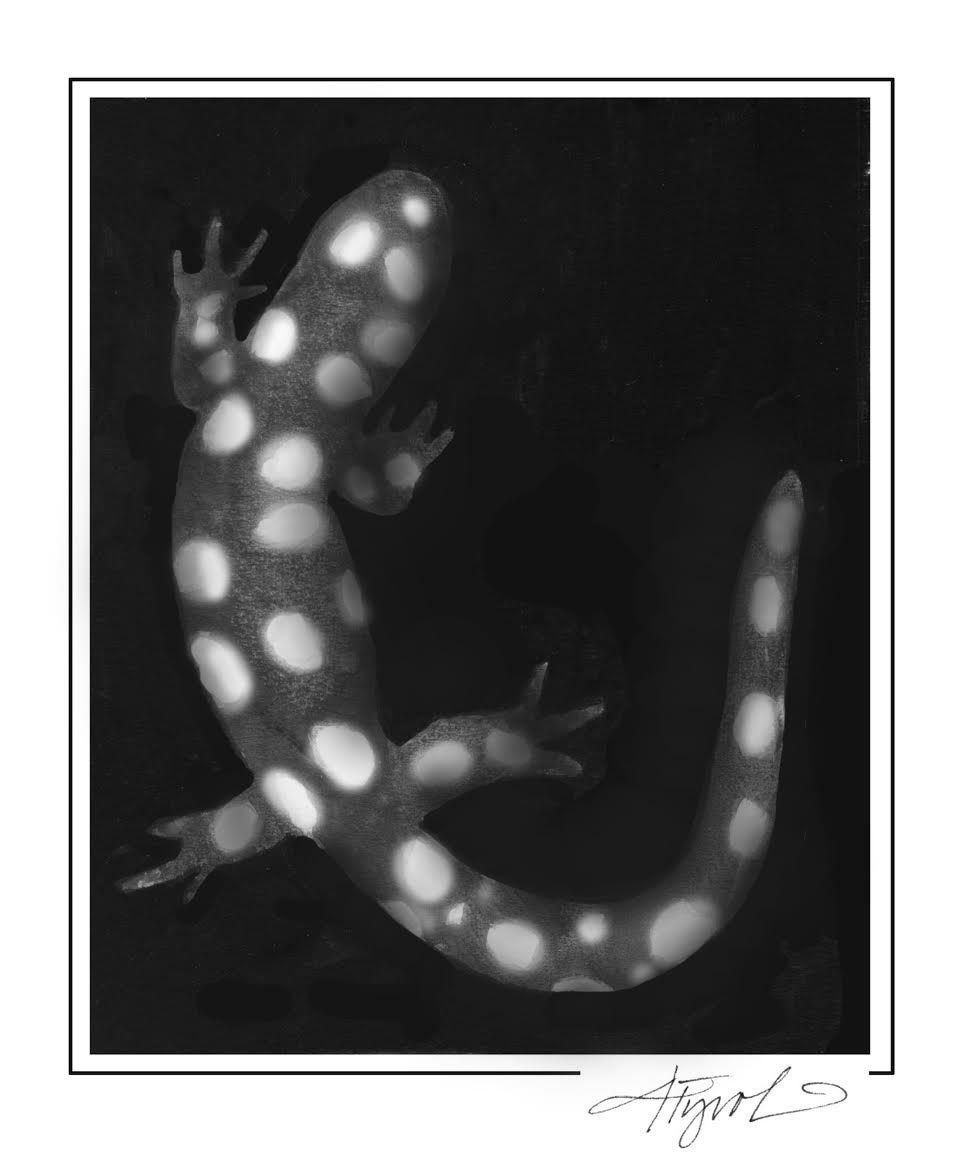When the winter snow melts and the spring rain begins, vernal pools appear on the landscape. These ephemeral wetlands form in depressions in forests or ridge lines and offer essential breeding habitats to amphibians and invertebrates, including wood frogs, spotted salamanders, and fairy shrimp. Because vernal pools dry up in high summer and are disconnected from other waterways, fish cannot survive in them – making them uniquely attractive to many amphibian and invertebrate species.
“It’s the lack of fish that allows them to treat it like a nursery with essentially no serious new aquatic predators,” said Kevin Tolan, staff biologist at the Vermont Center for Ecostudies and coordinator of the center’s vernal pool monitoring project.
Not all species that use vernal pools require pools to survive, but some do. Creatures who depend on vernal pools are known as obligate species. These include spotted salamanders, whose charcoal-colored bodies are decorated head-to-tail with lemon-yellow spots. They spend nearly the entire year underground, tunneling beneath the frost line to survive the cold. On the first warm, wet spring nights, they emerge to breed in the vernal pools in which they were born. A female spotted salamander can lay hundreds of eggs in one night. She lays eggs in ovular masses clinging to sticks and grasses near the pool’s surface. These masses can look like strange, forgotten crafting projects: jumbles of googly eyes chilled in jelly. Spotted salamanders can grow up to 10 inches and live as long as 20 years. Wood frogs, another obligate species, typically live for only five years and will lay thousands of eggs in one sitting. This breeding strategy ensures species survival even if their brief lifespan includes dry years when the vernal pool doesn’t refill.
While invertebrates and amphibians that use vernal pools do not have to contend with fish, they do face the threat of many other predators. “Anything will eat a little baby salamander,” Tolan said. Raccoons, minks, and skunks will happily snack on egg masses. Tolan has even seen pet dogs chowing down on amphibian eggs.
Predation at vernal pools is, in part, due to the time of year when they occur on the landscape. In early spring, the ground is still thawing, and there are few other sources of food. The pools offer a protein-packed buffet to species that are awakening from winter dormancy or returning from seasonal migration, including black bears, some raptors and wading birds, and several species of turtle.
“Even though they’re physically small compared to many other wetland types, because there’s so much activity in them at a time when the rest of the land is sparse, they can play an important role in early spring,” said Brett Amy Thelan, science director at the Harris Center for Conservation Education.
Solitary sandpipers have been spotted feeding at vernal pools in the spring on their long migrations from Central America, the Caribbean, and South America. They hunt alone, searching for crustaceans, insects, and amphibians. Broad-winged hawks are also known to hunt at vernal pools during their migration journeys from Central and South America. These crow-sized raptors love eating frogs, toads, and other amphibians and will also eat crustaceans and insects. Great blue herons also feed at vernal pools in early spring.
Barred owls are one of the most prolific predators at vernal pools. Although these predators typically hunt from perches high up in the trees, they’re not averse to getting their feet wet. “I’ve seen them hunting by going down into the water and shuffling through and picking salamanders in the shallows,” Thelan said. Trail cameras have captured these owls wading through pools and trapping amphibians under their talons. They’ll nibble on them with their sharp beaks and then fly off to finish their meal undisturbed.
Thelan leads salamander crossing brigades for the Center, which involves spending many rainy nights in early spring along roadsides throughout New Hampshire’s Monadnock region, helping frogs and salamanders safely cross busy roads and monitoring the migrating populations. “It is not uncommon to see a barred owl hunting
by the side of the road on those nights – they’re keyed in,” she said.
Now is a great time to search your local forests for vernal pools because wood frogs are becoming active again. Listen for the sound of their throaty, squabbling chorus on a warm day, and it will likely lead you to a vernal pool. You may even catch a predator stopping by for a tasty meal!
Emily Haynes is a writer currently living in Washington, D.C. An avid birder and hiker, she loves exploring the forests of the Northeast. Illustration by Adelaide Murphy Tyrol. The Outside Story is assigned and edited by Northern Woodlands magazine and sponsored by the Wellborn Ecology Fund of New Hampshire Charitable Foundation: nhcf.org.




